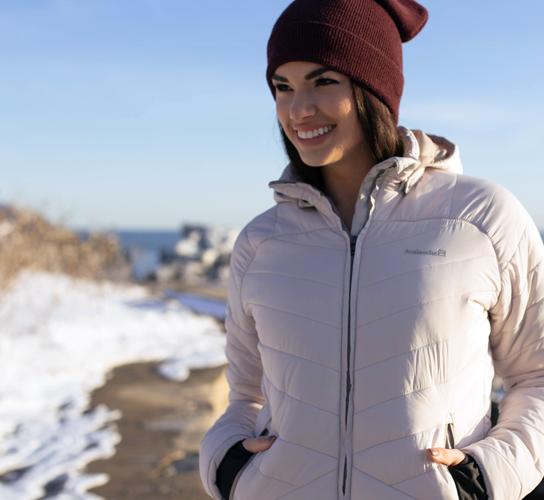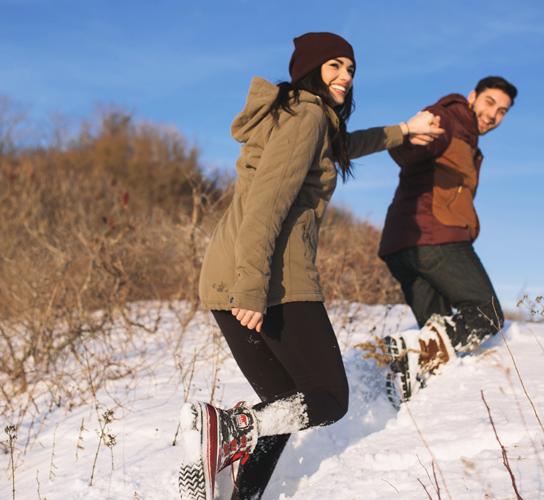
By Teddy Dondanville, Contributing Blogger
Your clothing serves more of a purpose than just representing your unique style or aesthetic. Your clothing also serves the functional purpose of protecting you from the elements.
So, with the winter flurries and temperatures dropping daily, I thought it would be helpful to talk about clothing layers for colder weather.
Clothing Layering Basics
To begin thinking about the different layers of your clothing as functional garments tasked with protecting you from the elements (and helping you look cool), it can be helpful to organize things in three categories– the base, mid, and outer layers.
The Base Layer is in Charge of Moisture Management
The closest clothing layer to your skin is the base layer. The base layer’s job is to wick (remove) moisture away from your skin. By wicking perspiration away from your skin, the base layer helps your skin stay dry and from becoming chilled.
The Mid-Layer Insulates Your Body From the Elements
The middle layer in your clothing system is in charge of capturing and retaining the heat your body naturally creates. The more efficiently the mid-layer can trap radiated heat, the warmer you will be.
The Outer Layer Provides Wind and Rain Protection
The furthest layer from your skin is the outer layer, also known as the “shell” layer. Your shell’s job is to protect you from wind, rain, and snow. While keeping the elements away, the shell must also allow your body and clothing layers to breathe or let your perspiration evaporate.

How to Choose The Best Layer
There is a lot to consider when thinking about what garments to wear for what weather. To help you think about your clothing layers more strategically, I’ll run through each layer and explain some important nuggets of info.
The Base Layer
For the base layer, you want to consider three things– fit, fabric, and thickness.
1. Fit: ideally, your base layer will comfortably and snuggly fit your body so wicking can occur.
2. Fabric: synthetic materials are superior for both wicking and drying. Wool is another great option, but avoid cotton at all costs.
3. Thickness: lightweight is best for mild conditions, midweight is a good all-around choice, and heavyweight materials are suitable for freezing temps.
The Mid-Layer
In terms of your mid-layer, it’s important to think about the insulation material, thickness, and coverage.

The Outer Layer
Lastly, for the outer layer, the two items you want to focus on are weatherproofing and breathability.
Ideal Weather-Specific Layering Systems
Here are some examples of ideal layering systems for specific types of weather forecasts.
Cold Weather
- Midweight long underwear on the top and bottom
- Exterior jacket with synthetic insulation
- Midweight fleece-lined pants
- Waterproof and breathable rain jacket (and maybe pants)
Wet Weather
- Lightweight baselayer on top and bottom
- Lightweight fleece jacket or sweater
- Synthetic and quick-drying pants
- Lightweight and breathable rain jacket and pants with vents
Hot Weather
- Lightweight synthetic base layers on top and bottom
- Synthetic and quick-drying shorts, pants, or convertible-pants
- Lightweight windbreaker jacket
Layering Tips For Cold Weather
-
Don’t wait: staying warm and dry is easier than trying to warm up or dry out. So stay ahead of the cold and wet weather by adjusting your layers.
-
Avoid cotton layers: cotton is comfy, but it’s notorious for soaking up moisture like a sponge.
-
Get the right fit: you’ll be more likely to adjust layers as necessary if they fit well and layer together nicely.

Colder Weather Means More Clothes, Not More Inside Time
You don’t have to escape inside just because the temperatures are cooling off for the Fall and Winter. Instead, with a well-devised layering system, you can continue your outside adventures in style.
When thinking about how to dress or what to shop for to complete your cold weather layering system, just remember– the base layer is for moisture management (avoid cotton), the mid layer is all about insulation (the thicker, the warmer), and the outer layer is for water and windproofing (don’t forget the vents).
Have fun out there and stay warm!


